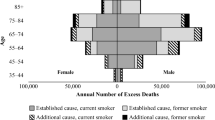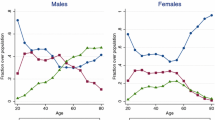Abstract
Purpose
Estimate quality-adjusted life expectancy (QALE) loss due to smoking and examine trends and state differences in smoking-related QALE loss in the U.S.
Methods
Population health-related quality of life (HRQOL) scores were estimated from the Behavioral Risk Factor Surveillance System. This study constructed life tables based on U.S. mortality files and the mortality linked National Health Interview Survey and calculated QALE for smokers, non-smokers, and the total population.
Results
In 2009, an 18-year-old smoker was expected to have 43.5 (SE = 0.2) more years of QALE, and a non-smoker of the same age was expected to have 54.6 (SE = 0.2) more years of QALE. Therefore, smoking contributed 11.0 (SE = 0.2) years of QALE loss for smokers and 4.1 years (37%) of this loss resulted from reductions in HRQOL alone. At the population level, smoking was associated with 1.9 fewer years of QALE for U.S. adults throughout their lifetime, starting at age 18.
Conclusions
This study demonstrates an application of a recently developed QALE estimation methodology. The analyses show good precision and relatively small bias in estimating QALE––especially at the individual level. Although smokers may live longer today than before, they still have a high disease burden due to morbidities associated with poor HRQOL.


Similar content being viewed by others
Abbreviations
- BRFSS:
-
Behavioral Risk Factor Surveillance System
- NHIS:
-
National Health Interview Survey
- MEPS:
-
Medical Expenditure Panel Survey
- HRQOL:
-
Health-related quality of life
- QALE:
-
Quality-adjusted life expectancy
- QALY:
-
Quality-adjusted life year
- QWB:
-
Quality of Well-being Scale
- YPLL:
-
Years of potential of life lost
- CDC:
-
U.S. Centers for Disease Control and Prevention
References
Surgeon General’s Report. (2004). The health consequences of smoking. http://www.cdc.gov/tobacco/data_statistics/sgr/2004/index.htm.
Mokdad, A. H., Marks, J. S., Stroup, D. F., & Gerberding, J. L. (2004). Actual cause of death in the United States, 2000. JAMA, 291(10), 1238–1245.
Centers for Disease Control and Prevention (CDC). (2008). Smoking-attributable mortality, years of potential life lost, and productivity losses—United States, 2000–2004. MMWR, 57, 1226–1228.
Centers for Disease Control and Prevention (CDC). (2010). Vital signs: nonsmokers’ exposure to secondhand smoke—United States, 1999–2008. MMWR, 59(35), 1141–1146.
Gold, M. R., Siegel, J. E., Russell, R. B., & Weinstein, M. C. (1996). Cost-effectiveness in health and medicine. New York: Oxford University Press.
The Secretary’s Advisory Committee on National Health Promotion and Disease Prevention Objectives for 2020. (2008). Phase I report: recommendations for the framework and format of healthy people 2020. http://www.healthypeople.gov/hp2020/advisory/PhaseI/PhaseI.pdf.
Rosenberg, M. A., Fryback, D. G., & Lawrence, W. F. (1999). Computing population-based estimates of health-adjusted life expectancy. Medical Decision Making, 19, 90–97.
Jia, H., Zack, M. M., & Thompson, W. W. (2011). State quality-adjusted life expectancy for U.S. adults from 1993 to 2008. Quality of Life Research, 20(6), 853–863.
Kaplan, R. M., Anderson, J. P., & Kaplan, C. M. (2008). Modeling quality-adjusted life expectancy loss resulting from tobacco use in the United States. Social Indicators Research, 81, 51–64.
Kaplan, R. M., Bush, J. W., & Berry, C. C. (1976). Health status: Types of validity and the index of well-being. Health Service Research, 11(4), 478–507.
Stewart, S. T., Cutler, D. M., & Rosen, A. B. (2009). Forecasting the effects of obesity and smoking on U.S. life expectancy. New England Journal of Medicine, 361, 2252–2260.
Frazier, E. L., Franks, A. L., & Sanderson, L. M. (1992). Using behavioral risk factor surveillance data. In: Using chronic disease data: A handbook for public health practitioners (pp. 4.1–4.17). Atlanta GA: Centers for Disease Control and Prevention.
Mokdad, A. H., Stroup, D. F., & Giles, W. H. (2003). Behavioral risk factor surveillance team public health surveillance for behavioral risk factors in a changing environment. Recommendations from the behavioral risk factor surveillance team. MMWR Recommendations Report, 52(RR–9), 1–12.
Jia, H., & Lubetkin, E. I. (2009). The statewide burden of obesity, smoking, low income and chronic diseases in the United States. Journal of Public Health (Oxford), 31(4), 496–505.
Chiang, C. L. (1984). Statistical inference regarding life table functions. In C. L. Chiang (Ed.), The life table and its applications (pp. 153–167). Malabar, FL: Robert E. Krieger Publishers.
Centers for Disease Control and Prevention (CDC). (2000). Measuring healthy days: Population assessment of health-related quality of life. U.S. Department of Health and Human Services. Centers for Disease Control and Prevention. National Center for Chronic Disease Prevention and Health Promotion. Division of Adult and Community Health.
Centers for Disease Control and Prevention (CDC). (2008). Summary of the Health-Related Quality of Life (HRQOL) Surveillance Expert Panel. National Center for Chronic Disease Prevention and Health Promotion, Division of Adult and Community Health (DACH). Atlanta, Georgia.
Jia, H., Lubetkin, E. I., Moriarty, D. G., & Zack, M. M. (2007). A comparison of healthy days and EuroQol EQ-5D measures in two US adult samples. Applied Research in Quality of Life, 2, 209–221.
Jia, H., & Lubetkin, E. I. (2008). Estimating EuroQol EQ-5D scores from population healthy days data. Medical Decision Making, 28(4), 491–499.
Jia, H., Zack, M. M., Moriarty, D. G., & Fryback, D. G. (2011). Predicting the EuroQol group’s EQ-5D index from CDC’s “Healthy Days” in a US sample. Medical Decision Making, 31(1), 174–185.
Shaw, J. W., Johnson, J. A., & Coons, S. J. (2005). U.S. valuation of the EQ-5D health states: Development and testing of the D1 valuation model. Medical Care, 43, 203–220.
Brocklebank, J. C., & Dickey, D. A. (2003). SAS ® for forecasting time series (2nd ed.). Cary, NC: SAS Institute Inc.
Rostron, B. (2011). Smoking-attributable mortality in the United States. Epidemiology, 22, 350–355.
Miniño, A. M., Xu, J., Kochanek, K. D., Tejada-Vera B. (2009). Death in the United States, 2007. NCHS Data Brief. Hyattsville, MD: National Center for Health Statistics. http://www.cdc.gov/nchs/data/databriefs/db26.pdf.
Zack, M. M., Moriarty, D. G., Stroup, D. F., Ford, E. S., & Mokdad, A. H. (2004). Worsening trends in adult health-related quality of life and self-rated health-United States, 1993–2001. Public Health Reports, 119(5), 493–505.
Jia, H., & Lubetkin, E. I. (2010). Trends in quality-adjusted life-years lost contributed by smoking and obesity. American Journal of Preventative Medicine, 38(2), 138–140.
Brazier, J., Roberts, J., & Deverill, M. (2002). The estimation of a preference-based measure of health from the SF-36. Journal of Health Economics, 21, 271–292.
Caraballo, R. S., Giovino, G. A., Pechacek, T. F., & Mowery, P. D. (2001). Factors associated with discrepancies between self-reports on cigarette smoking and measured serum cotinine levels among person aged 17 years or older: Third National Health and Nutrition Examination Survey, 1988–1994. American Journal of Epidemiology, 153, 807–814.
Blumberg, S. J., Luke, J. V. (2011). Wireless substitution: Early release of estimates from the National Health Interview Survey, January–June 2011. National Center for Health Statistics, December 2011, pp. 1–19. http://www.cdc.gov/nchs/data/nhis/earlyrelease/wireless201112.htm.
Acknowledgments
This study (HJ) is supported by a CDC contract (No. 200-2010-M-35363).
Author information
Authors and Affiliations
Corresponding author
Additional information
Disclaimer: The findings and conclusions in this article are those of the authors and do not necessarily represent the official position of the Centers for Disease Control and Prevention.
Appendix
Appendix
The QALE at age x is calculated by summarizing QALYs throughout remaining expected life starting at age x over the percent of population surviving to age x [7, 8]:
where y(t) are HRQOL scores at age t and S(t) is the survival function. Formulas to calculate QALE and their standard errors were provided by Jia et al. [8]. QALE for those at age x is:
The variance of this QALE estimate is:
where \( {\text{VAR}}(q) = \frac{{q^{2} (1 - q)}}{d} \) for age less than 85 and \( {\text{VAR}}(L_{85} ) = \frac{{\left( {e^{{ - \sum\nolimits_{k < 85} {n_{k} m_{k} } }} } \right)^{2} }}{{d_{85} m_{85}^{2} }}A_{18 - 24}^{2} \).
QALE loss was the difference in QALE between two groups: \( \Updelta_{x} = Q_{x}^{0} - Q_{x}^{1} \). Here, \( Q_{x}^{0} \) is QALE for non-smokers and \( Q_{x}^{1} \) is QALE for smokers (for individual QALE loss) or for total population (for population QALE loss). The variance of QALE loss is equal to \( {\text{Var}}(\Updelta_{x} ) = {\text{Var}}(Q_{x}^{0} ) + {\text{Var}}(Q_{x}^{1} ) - 2{\text{COV}}(Q_{x}^{0} ,Q_{x}^{1} ) \). The covariance term is approximated by
where \( \frac{{\partial Q^{0} }}{{\partial q^{0} }} = A_{i} \left( {\frac{ny}{2} + {\text{Q}}_{i + 1} } \right) \) and \( \frac{{\partial Q^{0} }}{{\partial y_{0} }} = A_{i} \left( {1 - \frac{{q_{i} }}{2}} \right) \) for i < 85.
Since the number of deaths is estimated from the proportion at risk and the hazard ratio, additional variation from the unreliability of using the estimated proportion (var(p)) and hazard ratio (var(h)) should be included in the variance estimation for q, the probability of dying:
The values of var(p) and var(h) are derived from methods of moments estimation (either using designed based on direct estimates or using model-based estimates). For the years 2007–2009, the death data were estimated from a time-series autoregressive moving average model (ARMA) from the 1993–2006 death rates [8, 22]. The death rate at year t, m t , is specified as ARMA(1,1) or \( m_{t} - \mu = \rho (m_{t - 1} - \mu ) + e_{t} - \beta e_{t - 1} \). The predicted death rates for these 3 years therefore should include additional uncertainty in their estimates, and the variance, var(m), from the ARMA model estimates was used to account for this.
Rights and permissions
About this article
Cite this article
Jia, H., Zack, M.M., Thompson, W.W. et al. Quality-adjusted life expectancy (QALE) loss due to smoking in the United States. Qual Life Res 22, 27–35 (2013). https://doi.org/10.1007/s11136-012-0118-6
Accepted:
Published:
Issue Date:
DOI: https://doi.org/10.1007/s11136-012-0118-6




